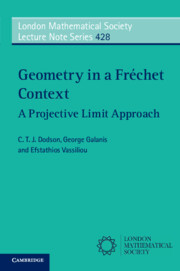Book contents
- Frontmatter
- Contents
- Preface
- 1 Banach manifolds and bundles
- 2 Fréchet spaces
- 3 Fréchet manifolds
- 4 Projective systems of principal bundles
- 5 Projective systems of vector bundles
- 6 Examples of projective systems of bundles
- 7 Connections on plb-vector bundles
- 8 Geometry of second order tangent bundle
- Appendix: Further study
- References
- List of Notations
- Subject index
8 - Geometry of second order tangent bundle
Published online by Cambridge University Press: 05 November 2015
- Frontmatter
- Contents
- Preface
- 1 Banach manifolds and bundles
- 2 Fréchet spaces
- 3 Fréchet manifolds
- 4 Projective systems of principal bundles
- 5 Projective systems of vector bundles
- 6 Examples of projective systems of bundles
- 7 Connections on plb-vector bundles
- 8 Geometry of second order tangent bundle
- Appendix: Further study
- References
- List of Notations
- Subject index
Summary
The second order tangent bundle T2B of a smooth manifold B consists of the equivalence classes of curves in B that agree up to their acceleration, and arises in a natural way in several problems of theoretical physics and differential geometry (cf., for instance, [DG05], [DR82]). However, the vector bundle structure on T2B is not as straightforward as that of the ordinary (viz. first order) tangent bundle TB of B; in fact, it relies on the choice of a linear connection on B.
Aiming at the reader's convenience, in §§ 8.1.1–8.1.3 we specialize to the ordinary tangent bundle a few facts from the theory of linear connections on vector bundles, exhibited in Chapter 1. In § 8.2 we proceed to the details of the structure of T2B, for a Banach manifold B. Our next target is to find out the extent of the dependence of the vector bundle structure of T2B on the choice of the linear connection on B. This naturally leads us to the notion of second order differentials (§ 8.3). With their help, we prove (in § 8.4) that related (or conjugate) connections induce—up to isomorphism—the same vector bundle structure on T2B.
The last two sections are devoted to the projective limits of second order tangent bundles (§ 8.5), and the generalized second order frame bundle (§ 8.6). Note that, whereas the tangent vectors of curves and velocities of particles naturally form vector bundles, their derivatives, which yield curvatures and accelerations, do not. In order to cover this gap, second order vector bundle structures are constructed for projective limits of Banach modelled manifolds.
The (first order) tangent bundle in brief
We transcribe a few features of the general theory of linear connections to the particular case of the tangent bundle of a Banach manifold. This will pave the way to the main topics of the present chapter.
Linear connections on manifolds
Let B be a Banach manifold with atlas {(Uα, ϕα)}α∈I.
- Type
- Chapter
- Information
- Geometry in a Fréchet ContextA Projective Limit Approach, pp. 245 - 272Publisher: Cambridge University PressPrint publication year: 2015



